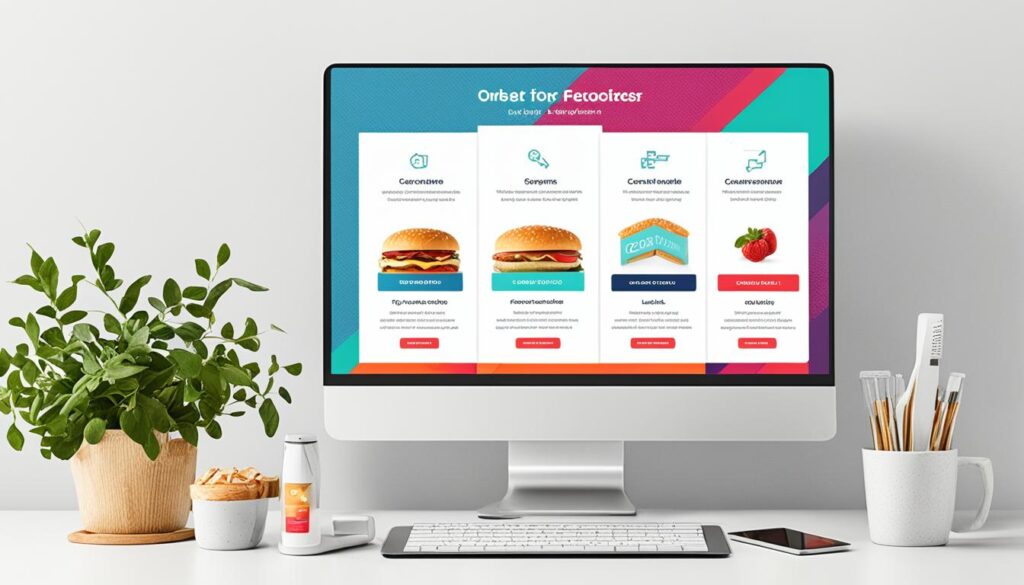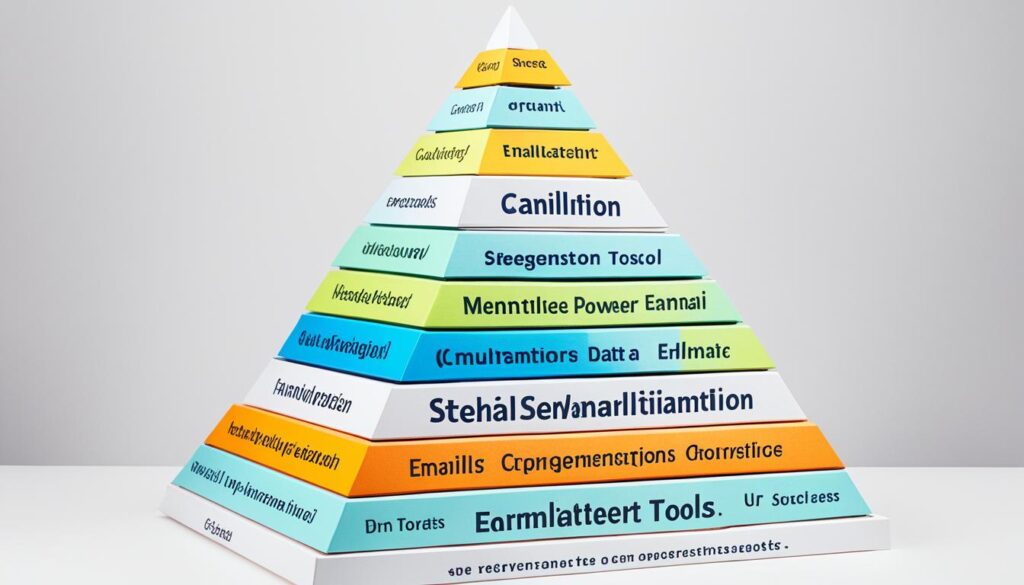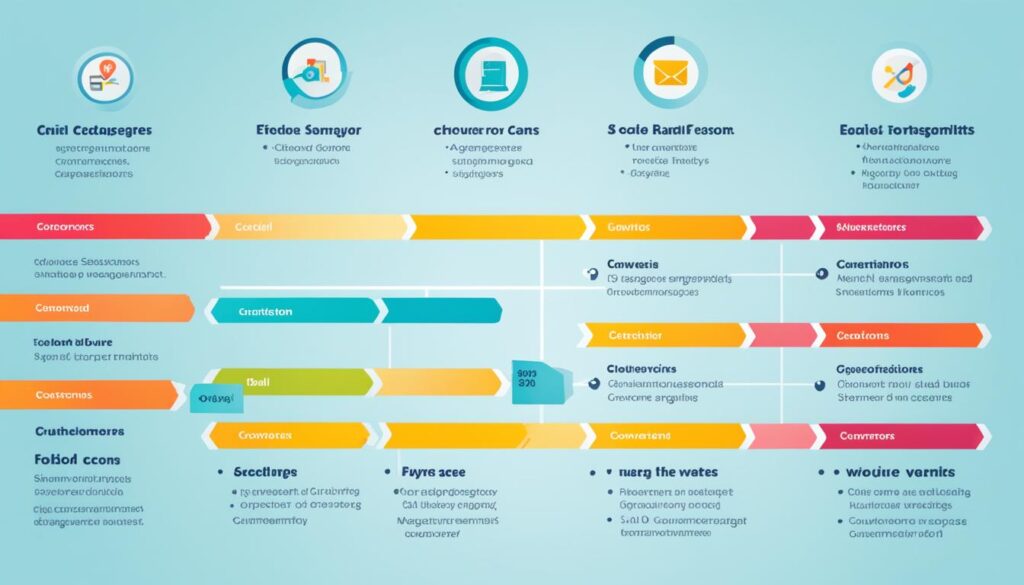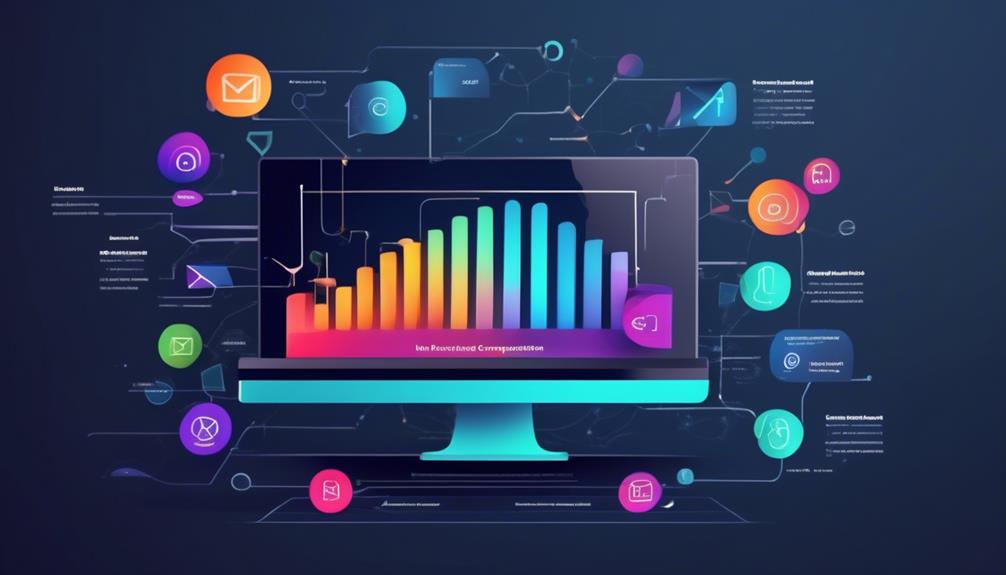Did you know that sending generic and impersonal emails could result in lower conversion rates and reduced customer loyalty? In today’s digital era, consumers are seeking authentic advertising stories that resonate with their individual preferences and interests. But how can marketers implement strategies to deliver personalized experiences on a broad scale?
Enter segmented email campaigns.
Email segmentation allows marketers to tailor their messages to each individual’s behavior and interests, creating a more personalized and engaging experience. By dividing your subscriber list into targeted segments, you can deliver content that speaks directly to your audience’s needs, leading to higher open rates, click-through rates, and conversion rates. Not only that, segmented emails are less likely to be marked as spam and can provide a more human and relatable experience for recipients.
In this article, we will explore the importance of email segmentation and how it can help you create authentic advertising stories in your segmented email campaign. From the advantages of segmentation to effective strategies and tools, we will provide you with the insights and inspiration you need to take your email marketing to the next level. So let’s dive in!
Key Takeaways:
- Email segmentation allows marketers to deliver personalized and relevant content to each segment of their audience.
- Segmented emails have higher open rates, click-through rates, and conversion rates.
- Segmented emails are less likely to be marked as spam and provide a more human and relatable experience for recipients.
- Email segmentation improves customer loyalty and helps marketers build a deeper connection with their audience.
- Effective email segmentation requires data collection, buyer persona development, behavioral analysis, and dynamic adaptation of segments.
The Importance of Email Segmentation
Email segmentation is crucial for delivering targeted and relevant content to different segments of your audience. By dividing your subscriber list based on shared characteristics, such as demographics or behavior, you can send personalized messages to each segment. This leads to improved open rates as recipients find the content more relevant and valuable.
Additionally, segmented emails have higher click-through rates because they are tailored to the recipient’s interests and needs. Personalization creates a more human and meaningful experience, building a stronger bond with the brand. Overall, email segmentation enhances engagement and ensures that your messages resonate with each segment’s preferences.
The Advantages of Email Segmentation
Email segmentation offers several advantages for marketers. Firstly, it improves conversion rates by allowing for personalized messages that cater to the specific interests and needs of subscribers. This fosters a deeper connection with the brand and increases the likelihood of desired actions, such as making a purchase or signing up for a webinar.
Segmentation also leads to a higher return on investment by increasing engagement rates and conversions. Sending targeted emails reduces costs by avoiding irrelevant content and decreasing the unsubscribe rate. Furthermore, email segmentation helps marketers avoid spam filters, ensuring that their messages reach the intended recipients’ inboxes. By providing a personalized and valuable experience, segmentation contributes to a better overall user experience and enhances brand loyalty.
| Advantages of Email Segmentation | |
|---|---|
| Improved conversion rates | Segmented emails cater to specific interests and needs, fostering a deeper connection with the brand and increasing desired actions. |
| Higher return on investment | Targeted emails reduce costs by avoiding irrelevant content and decreasing the unsubscribe rate. |
| Avoidance of spam filters | Email segmentation helps messages reach the intended recipients’ inboxes, increasing deliverability. |
| Enhanced user experience | Providing personalized and valuable experiences fosters brand loyalty and improves overall satisfaction. |

Strategies for Effective Email Segmentation
To implement effective email segmentation, we prioritize data collection to gather key insights about our subscribers. By leveraging relevant demographics, purchase history, and engagement metrics, we can create a more tailored email experience. Understanding the motivations and preferences of different segments is crucial, which is why we build detailed buyer personas based on the collected data.
Once we have established these personas, we can segment our email list accordingly and deliver content that resonates with each segment. Behavior analysis plays a pivotal role in segmenting our subscribers based on past interactions. This helps us provide targeted content that aligns with their specific interests and preferences, ultimately enhancing engagement.
However, it’s important to note that customer preferences and behaviors may evolve over time. To ensure continued relevance, we keep our segments dynamic and adapt them as needed. By staying up to date with our subscribers’ changing needs, we can deliver personalized content that speaks directly to their interests and behaviors.
Leveraging segmentation tools and software streamlines the entire process and enhances the effectiveness of our email campaigns. These tools allow us to automate the segmentation process, saving time and ensuring accuracy. With the ability to measure the success of our segmented campaigns through key metrics, we can make data-driven adjustments for continuous optimization.
Overall, by prioritizing data collection, leveraging buyer personas, conducting behavioral analysis, and dynamically adapting our segments, we can create successful email segmentation strategies that deliver personalized and relevant content to our subscribers.
| Strategies for Effective Email Segmentation | Benefits |
|---|---|
| Data collection (demographics, purchase history, engagement metrics) | Deeper understanding of subscriber preferences and motivations |
| Building detailed buyer personas | Targeted content delivery based on individual profiles |
| Behavioral analysis | Segmentation based on past interactions for enhanced engagement |
| Dynamic adaptation | Continued relevance as subscriber preferences evolve |
| Leveraging segmentation tools and software | Streamlining the process and enhancing campaign effectiveness |
| Measuring success through key metrics | Data-driven adjustments for continuous optimization |
Tailoring Email Content for Segmented Lists
Once your email list is segmented, it is crucial to customize the content for each segment. Understanding the unique characteristics and preferences of each group allows us to create relevant and personalized messaging that resonates with our recipients. By using language, imagery, and offers that align with their interests and preferences, we can provide a more engaging and valuable experience.
One effective strategy is to offer targeted offers that address the specific needs and behaviors of each segment. By tailoring our offers to match their preferences and pain points, we can significantly increase engagement and conversion rates. This personalization creates a sense of relevance and makes our emails more impactful.
“The key to successful email segmentation is providing content that speaks directly to your recipients’ needs and interests. By tailoring your emails to each segment, you ensure that your messages are not only relevant but also more valuable and meaningful to your audience.”
When crafting our emails, we should keep in mind the pain points and challenges specific to each segment. By addressing these issues directly, we can provide solutions and valuable insights that resonate with our recipients. This approach fosters a deeper connection and enhances engagement.
To illustrate the importance of tailoring email content for segmented lists, consider the following example:
| Segment | Interests | Personalized Content |
|---|---|---|
| New subscribers | Exploring our brand | Welcome email series introducing our products and services |
| Engaged customers | Interested in new features | Announcement of upcoming product update and exclusive access |
| Inactive users | Lapsed interest | Reactivation campaign with special incentives and offers |
By tailoring our email content to each segment’s specific interests and preferences, we can enhance relevance, personalization, and engagement. This targeted approach ensures that our emails provide value and resonate with our recipients, ultimately driving better results.

Tools and Software for Email Segmentation
Selecting the right tools and software for email segmentation is crucial for efficient and effective campaigns. To ensure seamless operations, it’s important to assess the segmentation capabilities and choose a platform that aligns with your business needs. Additionally, integration compatibility with your existing email marketing platform and CRM system is essential.
We recommend using user-friendly tools that offer automation features and scalability. These tools streamline the segmentation process, allowing you to efficiently manage and automate the creation of targeted email campaigns. Automation not only saves time but also ensures that your emails are reaching the right audience at the right time.
Data security is a top priority when it comes to email segmentation. Choose tools and software that have robust measures in place to protect subscriber information. By prioritizing data security, you can build trust with your audience and safeguard their personal data.
| Key Considerations for Email Segmentation Tools and Software | Benefits |
|---|---|
| Segmentation capabilities assessment | Ensure that the tools and software provide the necessary segmentation functionalities that meet your specific requirements. |
| Integration compatibility | Choose tools and software that seamlessly integrate with your existing email marketing platform and CRM system, enabling smooth operations. |
| User-friendly interface | Opt for tools and software that are easy to use, offering intuitive interfaces that simplify the segmentation process. |
| Automation features | Utilize tools and software that offer automation capabilities, allowing you to efficiently manage and automate the segmentation process. |
| Scalability | Choose tools and software that can handle a growing subscriber base and evolving segmentation needs, ensuring scalability as your business expands. |
| Data security measures | Opt for tools and software that prioritize data security, providing robust measures to protect subscriber information and maintain privacy. |

By leveraging segmentation tools and software, you can optimize your resources and deliver targeted content that drives better results. With the right tools in place, you can create more personalized and relevant email campaigns, leading to higher engagement, conversion rates, and customer satisfaction.
Measuring Success and Optimization in Email Segmentation
Measuring the success of our segmented email campaigns is crucial for optimization. By tracking key metrics, conducting A/B testing, and continuously refining our segmentation strategies, we can ensure ongoing relevancy and improve our email marketing results.
When it comes to measuring success, we focus on key metrics that provide valuable insights into the performance of our segmented campaigns. These metrics include:
- Open rates: This metric helps us understand the effectiveness of our subject lines and the level of interest generated among our subscribers.
- Click-through rates: By tracking click-through rates, we can evaluate the engagement levels of our segmented emails and assess the effectiveness of our call-to-actions.
- Conversion rates: Conversion rates give us a clear picture of how well our segmented emails are driving desired actions, such as purchases or sign-ups.
- Return on Investment (ROI): By analyzing the ROI of our segmented campaigns, we can assess the overall profitability and success of our email marketing efforts.
A/B testing is another valuable tool we use to optimize our segmented email campaigns. By testing different elements such as subject lines, email copy, visuals, and calls-to-action, we can gather data on what resonates best with each segment. This data-driven approach allows us to refine our content and create more impactful and engaging emails.
Continuous segmentation refinement is essential to ensure ongoing relevancy. We analyze performance metrics and customer feedback to adapt our segmentation strategies based on market trends and evolving customer behavior. By staying agile and responsive, we can deliver tailored messaging that genuinely connects with our audience.
To enhance personalization and engagement, we conduct dynamic content and offer personalized experiences using marketing automation tools. Leveraging these tools enables us to deliver relevant content to each recipient, increasing the chances of driving conversions and building stronger relationships with our subscribers.
Respecting subscriber preferences is a top priority for us. We allow opt-outs from certain segments to maintain a positive sender-receiver relationship and ensure that our subscribers receive the content they find most valuable.
Consistently monitoring performance metrics and adapting our segmentation strategies based on market trends and customer behavior leads to better email marketing results. Through data analysis and optimization, we can create email campaigns that truly resonate with our audience, driving higher engagement, conversions, and ultimately, business growth.

Realize the Benefits: Case Studies and Success Stories
Exploring real-world examples of businesses that have successfully implemented email list segmentation can provide valuable insights and inspiration. These case studies demonstrate how segmentation strategies have significantly improved engagement, conversions, and ROI. By learning from successful segmentation strategies, you can apply similar tactics and adapt them to your own email marketing endeavors.
Case Study 1: Company X
Segmentation Strategy: Tailoring Content to Interests
“We wanted to increase engagement and conversions in our email campaigns, so we implemented a segmentation strategy that focused on tailoring content to the interests of our subscribers. By analyzing past purchases, browsing behavior, and demographic data, we grouped our audience into segments and crafted personalized emails that spoke directly to their needs and preferences. The results were remarkable – our click-through rates increased by 30% and conversions by 20%, leading to a significant boost in ROI.”

Case Study 2: Brand Y
Segmentation Strategy: Lifecycle-based Segmentation
“We recognized the importance of targeting our subscribers at different stages of their customer journey, so we implemented lifecycle-based segmentation. By dividing our email list into segments based on where individuals were in the sales funnel, we were able to deliver targeted content that aligned with their specific needs. As a result, our open rates increased by 25%, and our email-driven revenue grew by 35%. This segmentation strategy allowed us to nurture leads and build stronger relationships with our customers.”
Success Story: Online Retailer Z
Segmentation Strategy: Personalized Recommendations
“To stand out in a competitive market, we knew we needed a segmentation strategy that would enable us to deliver highly personalized recommendations to our customers. By leveraging past purchase history and browsing behavior, we created segments tailored to different product categories and preferences. This allowed us to send targeted emails with personalized product recommendations, resulting in a 40% increase in click-through rates and a 15% increase in average order value. Our customers appreciated the relevant product suggestions, leading to increased customer satisfaction and repeat purchases.”
These case studies and success stories illustrate the power of segmentation strategies in email marketing. By implementing effective segmentation tactics, businesses can see significant improvements in key metrics such as engagement, conversions, and ROI. By understanding your audience and delivering personalized, relevant content, you can create impactful email campaigns that resonate with your subscribers and drive tangible results.
Conclusion
In conclusion, email segmentation is a powerful strategy for creating authentic advertising stories in a segmented email campaign. By dividing your subscriber list based on shared characteristics and tailoring your messages to each segment, you can deliver personalized and relevant content that improves engagement, conversion rates, and customer loyalty.
Through effective segmentation strategies, utilization of segmentation tools and software, and careful measurement of key metrics, you can optimize your email marketing efforts and create impactful and engaging campaigns. Email segmentation allows you to build a deeper connection with your audience, providing them with content that speaks directly to their needs and interests.
Embracing email segmentation is crucial for establishing a successful and effective email marketing strategy. By delivering targeted and personalized content, you can create authentic advertising stories that resonate with your subscribers, leading to increased brand loyalty and a stronger relationship with your audience. So, start implementing email segmentation today and unlock the full potential of your segmented email campaign!
FAQ
What is email segmentation?
Email segmentation is the practice of dividing your subscriber list into smaller segments based on shared characteristics, such as demographics or behavior. It allows you to send personalized messages to each segment, tailoring your content to their specific interests and needs.
Why is email segmentation important for my marketing campaigns?
Email segmentation is important because it allows you to deliver targeted and relevant content to different segments of your audience. This leads to improved open rates, higher click-through rates, and a more personalized and meaningful experience for your subscribers.
What are the advantages of email segmentation?
Email segmentation offers several advantages, including improved conversion rates, higher return on investment, reduced unsubscribe rates, and increased deliverability. By providing a personalized and valuable experience, segmentation enhances brand loyalty and overall user experience.
What strategies should I use for effective email segmentation?
Strategies for effective email segmentation include data collection, building detailed buyer personas, behavioral analysis, and dynamic adaptation. Personalizing content to each segment’s needs, interests, and behaviors is key. Using segmentation tools and software streamlines the process and enhances the effectiveness of email campaigns.
How do I tailor email content for segmented lists?
To tailor email content for segmented lists, it’s important to understand the characteristics and preferences of each group. Use language, imagery, and offers that align with their unique interests and preferences. Targeted offers that match the specific needs and behaviors of each segment can significantly increase engagement and conversion rates.
What tools and software can I use for email segmentation?
There are various tools and software available for email segmentation. When selecting a platform, consider segmentation capabilities, integration compatibility, user-friendliness, scalability, and data security. Leveraging segmentation tools and software streamlines the process and enhances the effectiveness of email campaigns.
How do I measure the success of segmented email campaigns?
Measuring the success of segmented email campaigns involves tracking key metrics such as open rates, click-through rates, conversion rates, and ROI. A/B testing different email elements helps determine what resonates best with each segment. Continuous segmentation refinement based on performance metrics and customer feedback ensures ongoing relevancy and optimization.
Can you provide examples of successful email segmentation strategies?
Real-world case studies and success stories showcase the benefits of email segmentation. These examples demonstrate how segmentation strategies have significantly improved engagement, conversions, and ROI. By learning from successful segmentation strategies, marketers can apply similar tactics and adapt them to their own email marketing endeavors.
What are the key takeaways for implementing email segmentation?
The key takeaways for implementing email segmentation are to prioritize data collection, build detailed buyer personas, personalize content, leverage segmentation tools and software, measure campaign success, and learn from real-world examples. Email segmentation is a powerful strategy for creating authentic advertising stories in a segmented email campaign that leads to deeper customer engagement and brand loyalty.










